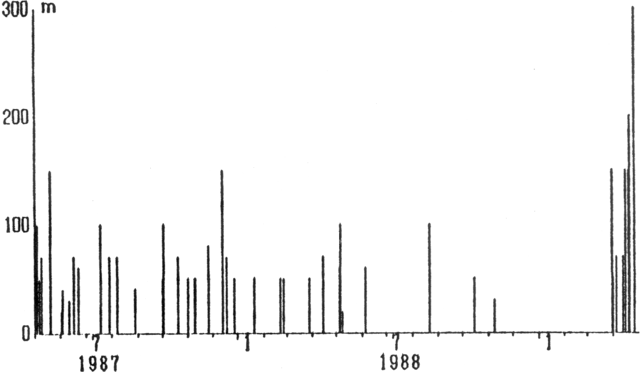Report on Asosan (Japan) — April 1989
Scientific Event Alert Network Bulletin, vol. 14, no. 4 (April 1989)
Managing Editor: Lindsay McClelland.
Asosan (Japan) Brief ash emission
Please cite this report as:
Global Volcanism Program, 1989. Report on Asosan (Japan) (McClelland, L., ed.). Scientific Event Alert Network Bulletin, 14:4. Smithsonian Institution. https://doi.org/10.5479/si.GVP.SEAN198904-282110
Asosan
Japan
32.8849°N, 131.085°E; summit elev. 1592 m
All times are local (unless otherwise noted)
On 27 April, the staff of AWS visited the crater rim as they have every day for the past 20 years. A vent on the SE floor of Crater 1 was releasing yellow vapor and ash to 30 m, accompanied by larger tephra. The Aso Volcano Disaster Prevention Authority closed a 1-km area near the crater to tourists. The area was reopened 2 May, when a field survey revealed only white vapor reaching ~5-6 m above the vent.
Glow on the crater floor has been observed every night since October 1988. A maximum temperature of 232°C was measured (with a infrared radiation thermometer) at a glowing site on 18 April.
Isolated tremor remained frequent in April. The daily number of tremor episodes was 100-250, with a monthly total of ~5,760 (figure 10). Amplitude of continuous tremor remained the same.
Geological Summary. The 24-km-wide Asosan caldera was formed during four major explosive eruptions from 300,000 to 90,000 years ago. These produced voluminous pyroclastic flows that covered much of Kyushu. The last of these, the Aso-4 eruption, produced more than 600 km3 of airfall tephra and pyroclastic-flow deposits. A group of 17 central cones was constructed in the middle of the caldera, one of which, Nakadake, is one of Japan's most active volcanoes. It was the location of Japan's first documented historical eruption in 553 CE. The Nakadake complex has remained active throughout the Holocene. Several other cones have been active during the Holocene, including the Kometsuka scoria cone as recently as about 210 CE. Historical eruptions have largely consisted of basaltic to basaltic andesite ash emission with periodic strombolian and phreatomagmatic activity. The summit crater of Nakadake is accessible by toll road and cable car, and is one of Kyushu's most popular tourist destinations.
Information Contacts: JMA.


